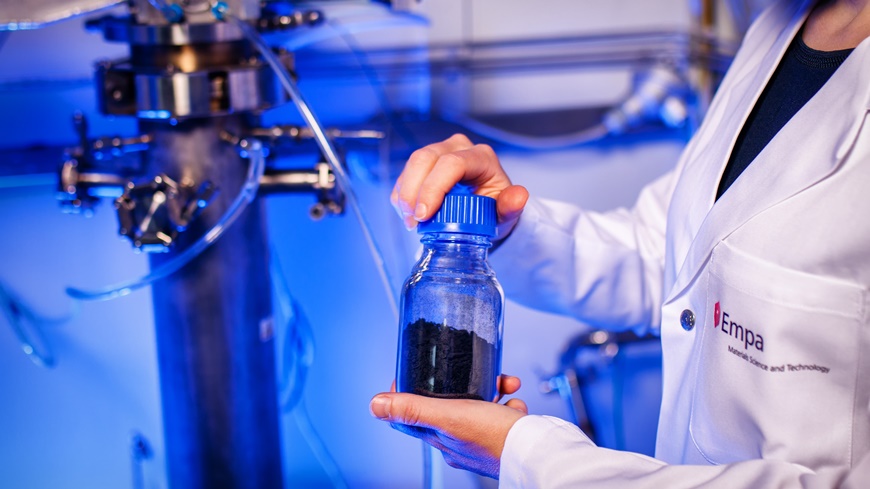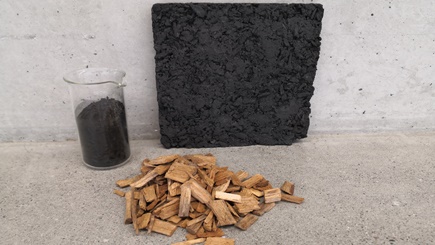Long-term use of carbon with pyrolysis
Catcher in the air: Removing CO2 from the atmosphere
Empa researchers want to use the pyrolysis of biomass to rid the atmosphere of excess CO2. Carbon stabilized and bound in this way can be used in a wide variety of areas, from construction to therapeutics. Initial research on building materials at Empa has already demonstrated the technology's potential. A larger pyrolysis reactor is now to be built to bridge the gap to industry.

What humans can only achieve with complex technical systems, nature can do effortlessly: removing CO2 from the atmosphere. Plants bind atmospheric carbon as they grow. When they decompose or are burned, they release the same amount of CO2 again. But what if we could prevent this re-release?
Empa researchers led by Jannis Wernery from Empa's Building Energy Materials and Components laboratory are looking into this. They are stabilizing the bound carbon so that it can be stored permanently or even processed into new materials. The method of choice for this is called pyrolysis. The plant material is heated with a reduced oxygen supply and carbonized in the process. As long as the resulting biochar is not burned, this process removes excess CO2 from the atmosphere – the vision of Empa's research initiative Mining the Atmosphere, in which Wernery and his team are involved.

The removal of CO2 from the atmosphere is absolutely crucial to achieve Switzerland's climate target of a maximum temperature increase of 1.5 °C by 2100. Initial projects at Empa, for instance as part of the joint initiatives «Speed2Zero» and «SCENE», show that biochar can be used to produce competitive insulating materials or as an additive to concrete, for example.
To ensure that this CO2-negative technology finds its way out of the laboratory and into industry, the researchers are planning to purchase a larger pyrolysis reactor based on a flexible, easily scalable technology. “This will enable us to establish a platform for further research into the production and utilization of biogenic carbon on a larger scale, also for other Empa labs,” says Wernery. The new reactor will also enable researchers to take a closer look at the other two products of pyrolysis, pyrolysis oil and pyrolysis gas. These mixtures of different carbon compounds are potential sources of synthetic fuels or raw materials for the chemical and pharmaceutical industries.
Zukunftsfonds
Empa's Zukunftsfonds is looking for private donations for outstanding research projects and talents that are not (yet) supported elsewhere. If you would also like to make a contribution to the project, you can find our donation form here.
Empa Quarterly #87
Medical technology
Focusing on people: In the Research Focus Area Health, Empa researchers are developing pioneering solutions for the medicine of tomorrow – precisely where “conventional” materials meet living ones, i.e. cells and tissue. There are polymers that light up when there is an infection with certain germs, tiny gold particles against cancer or “nanozymes” that help mothers with complications during pregnancy without harming the foetus – and much more.
Read the latest EmpaQuarterly online or download the PDF version.
Dr. Jannis Wernery
Building Energy Materials and Components
Phone +41 58 765 49 46
Loris Pandiani
Empa Zukunftsfonds
Phone +41 58 765 47 03
L'être humain au centre des préoccupations : dans le pôle de recherche « Santé », les chercheurs de l'Empa élaborent des solutions d'avenir pour la médecine de demain – précisément là où les matériaux « traditionnels » rencontrent des materiaux vivants, c'est-à-dire les cellules et les tissus. Il existe des polymères qui s'illuminent en cas d'infection par certains germes, de minuscules particules d'or contre le cancer ou des « nanozymes » qui aident la mère en cas de complications pendant la grossesse sans nuire au fœtus – et bien d'autres innovations encore.
Financial support for Empa research project: Plant-based insulation materials as CO2 sinks?
Carbon in concrete: Building on CO2
What is the potential of the “atmospheric mine”? Concrete as a carbon store
Mining the atmosphere: Out of thin air
New research initiative Mining the Atmosphere: The big clean-up in the atmosphere
-
Share






